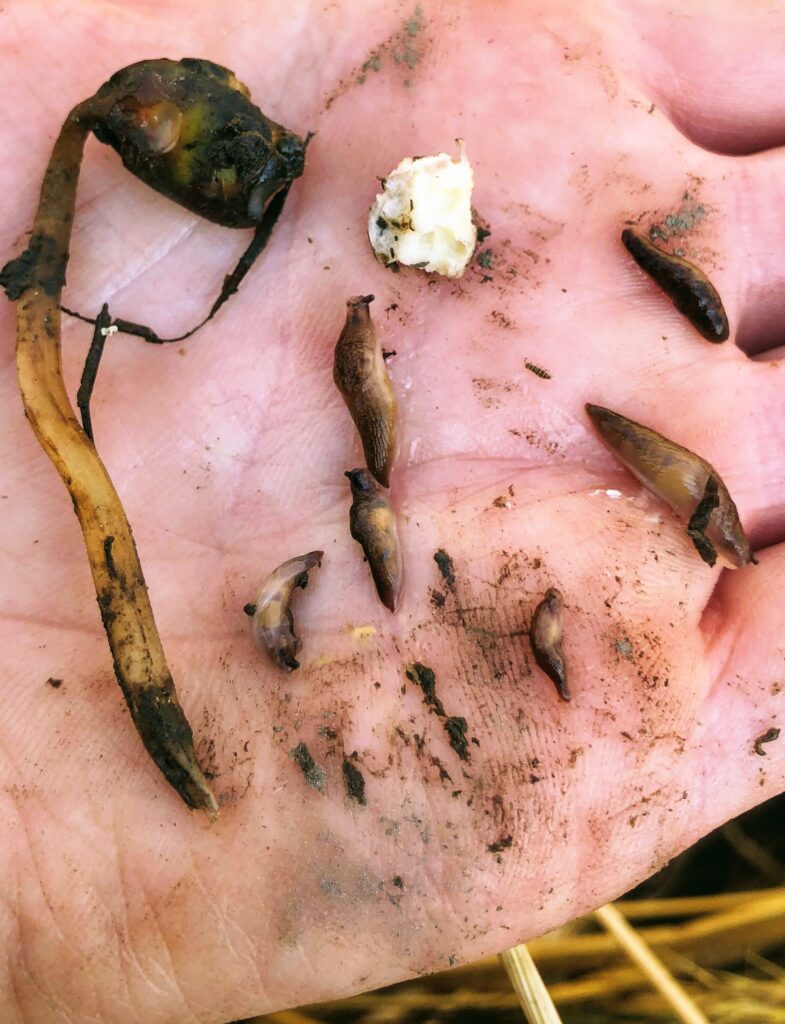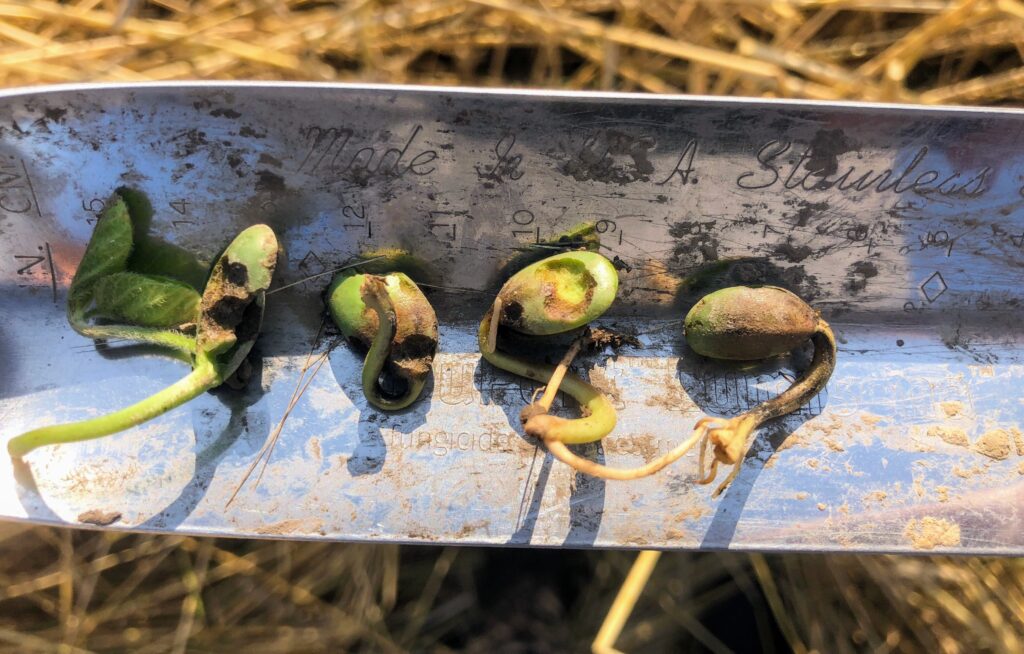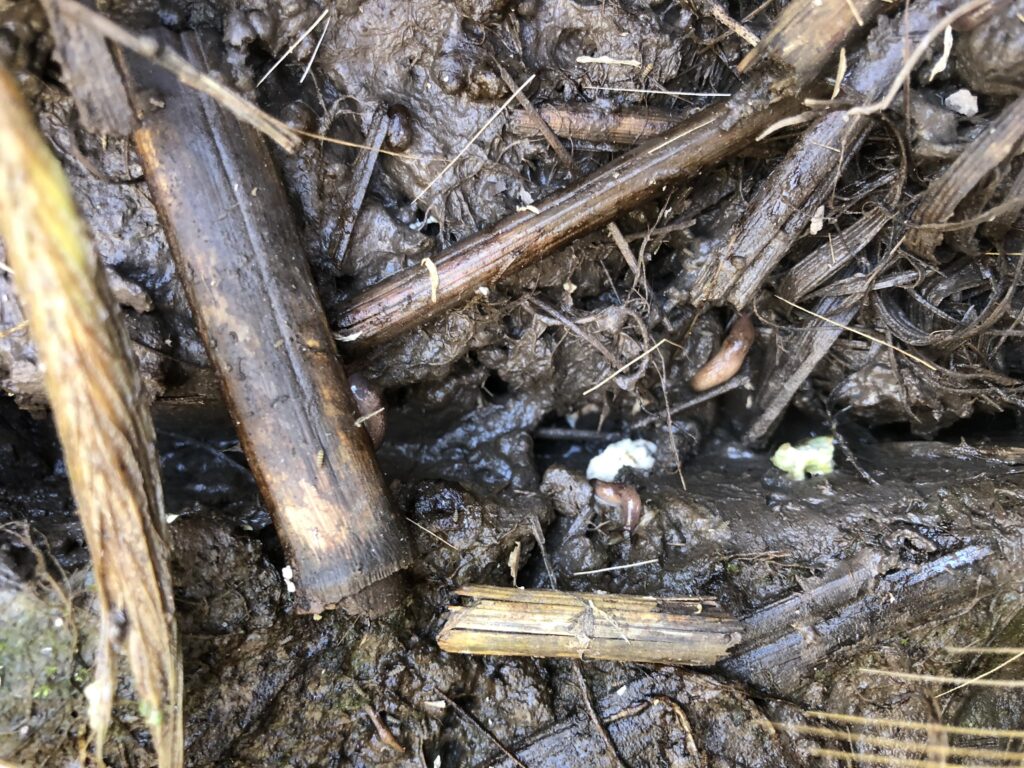Thanks to the mild winter and the extended cool, cloudy, and wet weather during the spring of 2024, this could be the worst year for slugs across the state. This is especially true if you had high populations of slugs in your fields last fall.
Slime trail. Video by Abigail Peterson, CCA, Illinois Soybean Association
Here are some notes and observations I’ve gathered after “Slugfest 2024.”
10. Signs that you may have slugs in your field include shiny dried slime trails as well as feeding damage. They often are hard to find during the day and feed at night.

Slug adult and juveniles look similar, but differ in size. (Photo – Abigail Peterson, CCA, Illinois Soybean Association)
9. There can be several different species of slugs, but all are slimy with tenacles. They overwinter as eggs and hatch in the spring. Once they hatch, it will be at least a week or two before damage is noticeable and they can use field residue as a food source before soybeans are planted. The larvae continue to develop into the summer, then lay eggs, so there is only one generation per year. Adult and juvenile slugs look similar but differ in size.
8. Salt will desiccate slugs and many of our fertilizers are salts. The trick is that slugs must be in contact with the salt (fertilizer) for it to work. Nitrogen can cause more damage in crops than slugs by burning them. If at least a half inch of rain occurs after the fertilizer is applied, the salts will be too diluted and not affect slugs. Excess nitrogen outside your intended nutrient management plan may not be environmentally sound practice.
7. Insecticides are useless against slugs because they are mollusks and not insects. In fact, insecticide applications and insecticides on seed treatments have been shown to make slugs worse because it can kill ground beetles that are beneficial insects that feed on slugs. Higher amounts of ground beetles can aid in slug suppression.
6. Field conditions with heavy residue or WEEDS during cool and cloudy conditions can be conducive to slug feeding, so the use of row cleaners or strip tillage may help deter slug damage. Pop up fertilizer may also be another tactic to promote early season growth of soybeans and outgrow slug feeding.
5. Recent research from Penn State states that the most diverse rotations tend to experience the fewest slugs and adding cover crops can increase diversity. A study by the University of Maryland determined that slugs increased when a rye cover crop was terminated 2 weeks before planting, but this was not true of the 3-way mix. There was a slight reduction in slug damage when planting green with termination a week after planting. In summary, Maryland’s data from a single site determined that cover crops probably don’t make slug damage worse and termination after planting may be a slug management option.
4. Slug baits can be used as a rescue treatment if there is severe slug feeding or seedings dying, but many states have not established economic thresholds. Treating certain areas of the field with more severe slug infestations might be more economical. Depending on the slug bait, it could be hard to evenly disperse over the field. It could be fatal to other animals/pets, need to be applied when slugs are present, be short lived, or become ineffective if it rains. Read and follow label guidelines.
3. Most of the damage that we see from slugs happens on the lower part of the plant (hypocotyl and cotyledons) before soybeans reach the V3 growth stage when growing conditions are slow. Soybeans are more sensitive to damage from slugs when compared to corn because the soybean’s growing point is above ground. If the soybean seedling is chewed below the cotyledons or if cotyledons are severely damaged, the plant will die. If soybean stand loss is severe, replant may be needed. Don’t confuse slug damage with that from an insect.
2. Look at the extended weather forecast before treating slugs. Sunny, hot weather will cause slugs to dry out, so they will hide out under residue. Our best defense against slugs is sunshine and when soybean seedlings are rapidly growing.
1. Make sure you close the seed furrow completely because damage and stand losses can be most severe when slugs are able to easily enter open seed slots to feed on seeds before they germinate as well as seedlings.
Resources:
Slugs in Soybean | NC State Extension Publications (ncsu.edu)
Slugs in Soybeans — KyGrains.info
2024 Pennsylvania Slug Monitoring Project (psu.edu)
Slugs as Pests of Field Crops (psu.edu)
Slug Damage to Soybeans—Do Cover Crops Help or Hurt? | University of Maryland Extension (umd.edu)




 and then
and then